Catalogue of the Type Specimens of Amphibians and Reptiles in the Herpetological Museum of the Chengdu Institute of Biology,Chinese Academy of Sciences: V. Viperidae (Reptilia, Serpentes)
Peng GUO, Qin LIU, Jiatang LI, Yan CAOand Yuezhao WANG
1College of Life Science and Food Engineering, Yibin University, Yibin 644007, China
2Chengdu Institute of Biology, Chinese Academy of Sciences, Chengdu 610041, Sichuan, China
Catalogue of the Type Specimens of Amphibians and Reptiles in the Herpetological Museum of the Chengdu Institute of Biology,Chinese Academy of Sciences: V. Viperidae (Reptilia, Serpentes)
Peng GUO1*, Qin LIU1, Jiatang LI2, Yan CAO2and Yuezhao WANG2
1College of Life Science and Food Engineering, Yibin University, Yibin 644007, China
2Chengdu Institute of Biology, Chinese Academy of Sciences, Chengdu 610041, Sichuan, China
In China, there are about 37 species of vipers belonging to 12 genera in the family Viperidae. In the Herpetological Museum of the Chengdu Institute of Biology (CIB), Chinese Academy of Sciences, the type specimens of snakes represent seven species in four genera. As a series of reports on the type specimens of Amphibians and Reptilies deposited in the Herpetological Museum of CIB, this paper focuses on the venomous snake family Viperidae in the collections at this Museum.
snake, type specimen, Viperidae, China, taxonomy
As a series of reports on the type specimens of Amphibians and Reptilies deposited in the Herpetological Museum of the Chengdu Institute of Biology (CIB),Chinese Academy of Sciences (CAS), this paper will focus on the serpent family Viperidae. The Viperids are advance snakes under the Serpentes. There are currently 12 genera and 37 recognized species in China (Uetz and Hošek, 2015). In the CIB collection, the type specimens of Viperidae belong to seven species in four genera.
In recent years, Asian pit vipers attracted many herpetologists to study their systematics, biogeography and evolution, and considerable work has been published on the topic (e.g. Malhotra and Thorpe, 2004; Guo et al.,2007; Malhotra et al., 2011). Ongoing studies based on more extensive sampling, allowed several new taxa to be described successively (e.g. Guo and Wang, 2011; Yang et al., 2011). In order to benefit the scientists interested in the systematics of this group, it is necessary to provide a list of the type specimens in the museum, and some of the Amphibian and Reptile type catalogues have alreadybeen published (e.g. Guo et al., 2012; Xiong et al., 2012). Some data on body dimension and scalation characters are also provided (Tables 1-5). The abbreviations used in the tables are: SVL: snout-ventral length; TL: tail length;SPL: supralabial; IFL: infralabial; DS; Dorsal scale; VS:Ventral scale; SC: Subcaudal scale.
Gloydius shedaoensis (Zhao, 1979)
Published name: Agkistrodon shedaoensis Zhao, 1979. Acta Herpetol Sin, Chengdu, [old ser.], 1(1): 4-6.
Holotype: CIB 012816 (formerly CIB 79I0005), Male.(Figure 1)
Type locality: Snake Island, Lüshun, Liaoning Province,China.
Distribution: Snake Island, Lüshun, Liaoning Province,China
Other specimens (43): Snake Island, Lüshun, Liaoning(CIB series 012817-46, 012952, 072426, 072550,078098-99, 083863-70).
Ovophis monticola zhaokentangi Zhao, 1995
Published name: Ovophis monticola zhaokentangi Zhao,1995. Sichuan J Zool, Chengdu, 14(3): 109.
Paratype: CIB 740003, Male; Pianma, Lushui Co.,Yunnan Province; 1980 m; 3. 17, 1974.
Comments: This specimen is unaccounted for loss in the CIB collection. Malhotra et al. (2011) synonymized O.monticola zhaokengtangi with O. zayuensis.

Table 1 The body dimension and measurement of the type specimens of Ovophis zayuensis.

Table 2 The body dimension and measurement of the specimens of Protobothrops mangshanensis (from Zhao et al., 1998).

Table 3 The body dimension and measurement of the type specimens of Protobothrops xiangchengensis (from Zhao, Jiang and Huang,1978).
Ovophis zayuensis (Jiang, 1977)
Published name: Trimeresurus monticola zayuensis Jiang, 1977 in Zhao E. M. and Jiang Y. M. 1977. Acta Zool Sin, Peking, 23(1): 64-71.
Holotype: CIB 013375 (formerly CIB73I5024), Male.(Figure 2)
Type locality: Chayu Co., Xizang AR, China.
Allotype: CIB 013376, Female.
Other specimens (1): Chayu Co., Xizang (CIB 013377). Distribution: Xizang (Chayu and Motuo), Yunnan(Gongshan), China.
Comments: Zhao (1995) elevated this taxon to a full species. Malhotra et al. (2011) synonymized O. monticola zhaokengtangi with O. zayuensis.
Protobothrops mangshanensis (Zhao, 1990)
Published name: Trimeresurus mangshanensis Zhao E. M. in Zhao E. M. and Chen Y. H. 1990. Sichuan J Zool. Chengdu, 9(1): 11-12.
Noetype: CIB 098485, Juvenile male (Figure 3)
Type locality: Pingkeng, Mt. Mang, Yizhang Co., Hunan Province, China; 700-900 m.
Paratype: CIB 013330, Juvenile.
Distribution: Hunan and Guangdong Province, China
Other specimens (9): Yizhang Co., Hunan Province,China (CIB series 01331-38, 078632).
Comments: The holotype has been got lost, thus Guo et al. (2012) designated a noetype for this species. This species is currently listed as Endangered (EN) under IUCN Red List Criteria (IUCN, 2012).
Protobothrops xiangchengensis (Zhao, Jiang and Huang, 1978)
Published name: Trimeresurus xiangchengensis Zhao,Jiang and Huang, 1978. Mater Herpetol Res, Chengdu, 4:21.
Holotype: CIB 013918 (formerly CIB725050), Male.(Figure 4)
Type locality: Qianjing Town, Xiangcheng Co., Sichuan Province, China.
Allotype: CIB 013921, Female.
Distribution: Western Sichuan and Yunnan, China.
Other specimens (77): Xiangcheng Co., Sichuan (CIB series 013916-17, 013919-20, 013922-23, 072443);Jiulong Co., Sichuan (CIB series 01392-35, 013937-44,013946-49, 097452-55); Kangding Co., Sichuan (CIB 013936); Batang Co., Sichuan (CIB 013945); Xiaojing Co., Sichuan (CIB 072442); No detail locality (CIB series 083934-72).

Figure 1 Dorsal (A) and ventral (B) views of the holotype of Gloydius shedaoensis (Zhao, 1979) (CIB 012816).
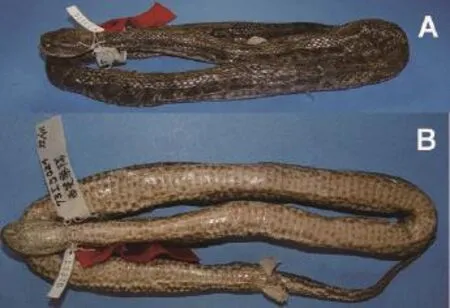
Figure 2 Dorsal (A) and ventral (B) views of the holotype of Ovophis zayuensis (Jiang, 1977) (CIB 013375).
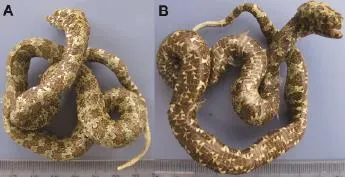
Figure 3 Dorsal (A) and ventral (B) views of the holotype of Protobothrops mangshanensis (Zhao, 1990) (CIB 098485).
Viridovipera medoensis (Zhao, 1977)
Published name: Trimeresurus medoensis Zhao, 1977 in Zhao E. M. and Jiang Y. M. 1977. Acta Zool Sin, Peking,23(1): 64-71.
Holotype: CIB 013612 (formerly CIB 73II5208), Male.(Figure 5)
Type locality: Near A-ni Bridge, Motuo Co., Xizang AR,China.
Allotype: CIB 013611, Male.
Distribution: Motuo Co., Xizang, China.
Comments: Malhotra and Thorpe (2004) moved this species from Trimeresurus to the newly erected genus Viridovipera as V. medoensis.
Viridovipera stejnegeri chenbihuii (Zhao, 1995)
Published name: Trimeresurus stejnegeri chenbihuii Zhao, 1995. Sichuan J Zool, Chengdu, 14(3): 107-112.
Holotype: CIB 013898 (formerly CIB 64III5599), Male.(Figure 6)
Type locality: Diaoluoshan, Lingshui Co., Hainan Province, China.
Allotype: CIB 013891, Female.
Distribution: Hainan, China.
Other specimens (28): Lingshui Co., Hainan (CIB series 013885-89, 013894-897, 013899-913, 013915);Qiongzhong, Hainan (CIB series 013888, 013890,013892-93, 013914, 078044).
Comments: Malhotra and Thorpe (2004) moved the species Trimeresurus stejnegeri to the newly described genus Viridovipera as V. stejnegeri chenbihuii. This subspecies is maybe not a valid subspecies based on recent phylogenetic studies (Guo et al. unpubl. data)
Acknowledgements This project is funded by the National Natural Science Foundation of China(NSFC31372152) and the Scientific Research Fund of Sichuan Provincial Education Department (13TD0027) to PG.
References
Gumprecht A., Tillack F. 2004. Proposal for a replacement name of the snake genus Ermia Zhang, 1993. Russ J Herpetol, 11:73-76
Guo P., Li J. T., Chen Y. Y., Wang Y. Z. 2012 Designation of a Neotype for Protobothrops mangshanensis (Zhao, 1990). Asian Herpetol Res, 3(4): 340-341
Guo P., Liu Q., Li J. T., Zhong G. H., Chen Y. Y., Wang Y. Z. 2012 Catalogue of the Type Specimens of Amphibians and Reptiles in the Herpetological Museum of the Chengdu Institute of Biology, Chinese Academy of Sciences: III. Snakes excluding Viperids (Reptilia, Serpentes). Asian Herpetol Res, 3(4): 334-339
Guo P., Malhotra A., Li P. P., Creer S., Pook C. E. 2007 New evidence on the phylogenetic position of the poorly known Asian pitviper Protobothrops kaulbacki (Serpentes: Viperidae:Crotalinae) with a redescription of the species and a revision of the genus Protobothrops. Herpetol J, 17: 237-246
Guo P., Wang Y. Z. 2011 A new genus and species of cryptic Asian green pitviper (Serpentes, Viperidae, Crotalinae) from southwest China. Zootaxa 2918: 1-14
Guo P., Zhang F. J., Chen Y. Y. 1999. Catalogue of type specimens of reptiles in the Herpetological Collections of Chengdu Institute of Biology, the Chinese Academy of Sciences. Asiatic Herpetol Res, Berkeley (USA), 8: 43-47
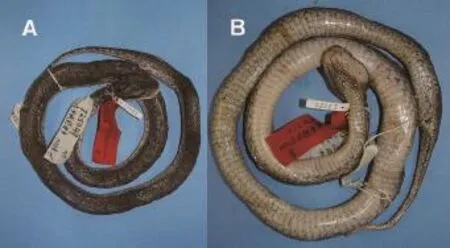
Figure 4 Dorsal (A) and ventral (B) views of the holotype of Protobothrops xiangchengensis (Zhao, Jiang and Huang, 1978)(CIB 013918).
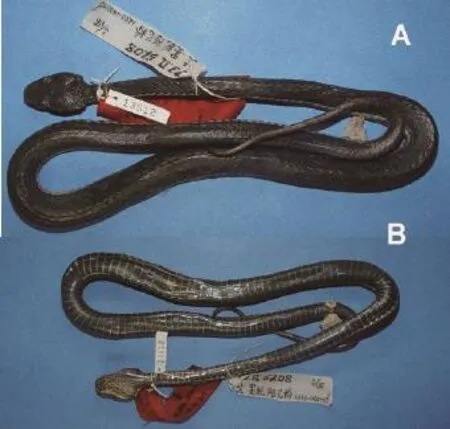
Figure 5 Dorsal (A) and ventral (B) views of the holotype of Viridovipera medoensis (Zhao, 1977) (CIB 013612).

Figure 6 Dorsal (A) and ventral (B) views of the holotype of Viridovipera stejnegeri chenbihuii (Zhao, 1995) (CIB 013898).

Table 4 The body dimension and measurement of the type specimens of Viridovipera medoensis (from Zhao and Jiang, 1977).

Table 5 The body dimension and measurement of the specimens of Viridovipera stejnegeri chenbihuii.
Malhotra A., Dawson K., Guo P., Thorpe R. S. 2011.Phylogenetic structure and species boundaries in the mountain pitviper Ovophis monticola (Serpentes: Viperidae: Crotalinae) in Asia. Mol Phylogenet Evol, 59: 444-457
Malhotra A., Thorpe R. S. 2004 A phylogeny of four mitochondrial gene regions suggests a revised taxonomy for Asian pitvipers(Trimeresurus and Ovophis). Mol Phylogenet Evol, 32: 83-100
Uetz P., Hošek J. The Reptile Database. Available at: http://www. reptile-database.org, accessed March 21, 2015
Xiong J. L., Chen Y. Y., Zeng X. M. 2012 Catalogue of the Type Specimens of Amphibians and Reptiles in the Herpetological Museum of the Chengdu Institute of Biology, Chinese Academy of Sciences: II. Hynobiidae (Amphibia, Urodela). Asian Herpetol Res, 3(4): 327-333
Yang J. H., Orlov N. L., Wang Y. Y. 2011 A new species of pitviper of the genus Protobothrops from China (Squamata: Viperidae). Zootaxa, 2936: 59-68
Zhao E. M. 1979. A new Agkistrodon from Shedao (Snake Island),Liaoning. Acta Herpetol Sin, 1 (1): 4-6
Zhao E. M. 1995. Taxonomic status of some snake species and subspecies. J Suzhou Railway Teachers College, Suzhou, 12 (2):36-39
Zhao E., Chen Y. 1990. Description of a new species of the genus Trimeresurus. Sichuan J Zool, 9 (1): 11-12
Zhao E. M., Huang M. H., Zong Y. 1998. Fauna Sinica: Reptilia,Vol. 3, Squamata, Serpentes. Beijing: Science Press
Zhao E. M., Jiang Y. M. 1977. A survey of reptiles in Xizang Autonomous Region, with faunal analysis and description of new forms. Acta Zool Sin, Beijing, 23 (1): 64-71
Zhao E. M., Jiang Y. M., Huang, Q. Y. 1978. Three new snake species from China. Mater Herpetol Res, Chengdu, 4: 21
*
Prof. Peng GUO, from the College of Life Science and Food Engineering, Yibin University, Sichuan, China, with his research focusing on herpetology, particularly molecular systematics,morphology evolution, biogeography and population genetics of Asian reptiles.
E-mail: ybguop@163.com
13 March 2015 Accepted: 12 November 2015
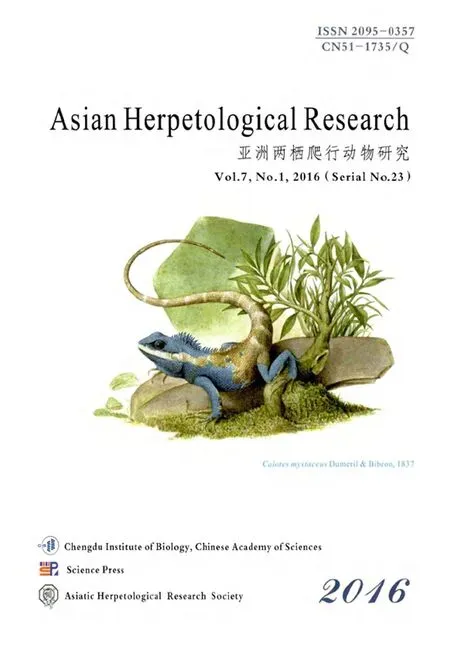 Asian Herpetological Research2016年1期
Asian Herpetological Research2016年1期
- Asian Herpetological Research的其它文章
- First Record of the Poorly Known Skink Sphenomorphus oligolepis(Boulenger, 1914) (Reptilia: Squamata: Scincidae) from Seram Island, Maluku Province, Indonesia
- The Breeding Ecology of a Critically Endangered Salamander, Hynobius amjiensis (Caudata: Hynobiidae), Endemic to Eastern China
- Effects of Predation by Invasive Western Mosquitofi sh (Gambusia affi nis) on Survival of Eggs, Embryos and Tadpoles of Pelophylax nigromaculatus and Duttaphrynus melanostictus in South China
- No Evidence for Signifi cant Effect of Body Size and Age on Male Mating Success in the Spot-legged Treefrog
- Effects of Pesticide Exposure on Embryonic Development and Hatchling Traits of Turtles
- Soundscape Dynamics at Anuran Reproductive Sites in Pannonian Biogeographical Region: Effects of Road Noise on Vocal Activity
